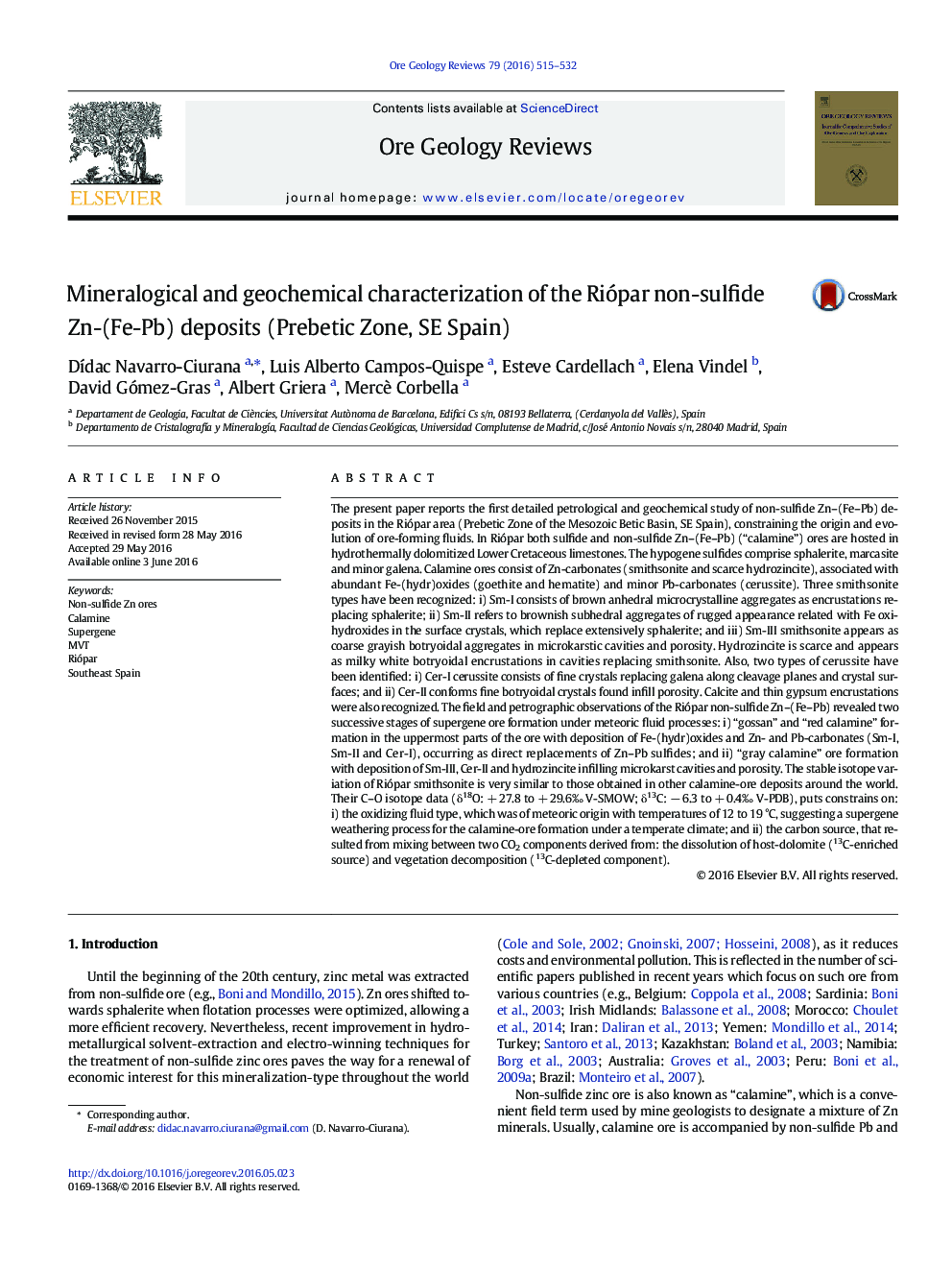| کد مقاله | کد نشریه | سال انتشار | مقاله انگلیسی | نسخه تمام متن |
|---|---|---|---|---|
| 4696810 | 1637227 | 2016 | 18 صفحه PDF | دانلود رایگان |

• The Riópar Zn-(FePb) non-sulfide mineral assemblage consists of smithsonite, Fe-(hydr)oxides, cerussite and hydrozincite.
• δ18O composition of smithsonite have a uniform, pointing to a constant isotopic source and precipitation temperatures.
• δ13C values of smithsonite indicates precipitation by mixing of at least two carbon sources.
The present paper reports the first detailed petrological and geochemical study of non-sulfide Zn–(FePb) deposits in the Riópar area (Prebetic Zone of the Mesozoic Betic Basin, SE Spain), constraining the origin and evolution of ore-forming fluids. In Riópar both sulfide and non-sulfide Zn–(FePb) (“calamine”) ores are hosted in hydrothermally dolomitized Lower Cretaceous limestones. The hypogene sulfides comprise sphalerite, marcasite and minor galena. Calamine ores consist of Zn-carbonates (smithsonite and scarce hydrozincite), associated with abundant Fe-(hydr)oxides (goethite and hematite) and minor Pb-carbonates (cerussite). Three smithsonite types have been recognized: i) Sm-I consists of brown anhedral microcrystalline aggregates as encrustations replacing sphalerite; ii) Sm-II refers to brownish subhedral aggregates of rugged appearance related with Fe oxi-hydroxides in the surface crystals, which replace extensively sphalerite; and iii) Sm-III smithsonite appears as coarse grayish botryoidal aggregates in microkarstic cavities and porosity. Hydrozincite is scarce and appears as milky white botryoidal encrustations in cavities replacing smithsonite. Also, two types of cerussite have been identified: i) Cer-I cerussite consists of fine crystals replacing galena along cleavage planes and crystal surfaces; and ii) Cer-II conforms fine botryoidal crystals found infill porosity. Calcite and thin gypsum encrustations were also recognized. The field and petrographic observations of the Riópar non-sulfide Zn–(FePb) revealed two successive stages of supergene ore formation under meteoric fluid processes: i) “gossan” and “red calamine” formation in the uppermost parts of the ore with deposition of Fe-(hydr)oxides and Zn- and Pb-carbonates (Sm-I, Sm-II and Cer-I), occurring as direct replacements of ZnPb sulfides; and ii) “gray calamine” ore formation with deposition of Sm-III, Cer-II and hydrozincite infilling microkarst cavities and porosity. The stable isotope variation of Riópar smithsonite is very similar to those obtained in other calamine-ore deposits around the world. Their CO isotope data (δ18O: + 27.8 to + 29.6‰ V-SMOW; δ13C: − 6.3 to + 0.4‰ V-PDB), puts constrains on: i) the oxidizing fluid type, which was of meteoric origin with temperatures of 12 to 19 °C, suggesting a supergene weathering process for the calamine-ore formation under a temperate climate; and ii) the carbon source, that resulted from mixing between two CO2 components derived from: the dissolution of host-dolomite (13C-enriched source) and vegetation decomposition (13C-depleted component).
Figure optionsDownload as PowerPoint slide
Journal: Ore Geology Reviews - Volume 79, December 2016, Pages 515–532